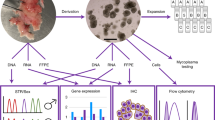Summary
We have compared hormone production by early gestation and term human placental trophoblasts cultured in Ham's F10 medium containing 10% fetal bovine serum with that by cells cultured in serum-free HB102 medium. Mean daily production of progesterone on Days 3 to 7 was approximately 25% less by both early gestation and term cells cultured in HB102 as compared to Ham's F10, but production was maintained at a stable level for at least 7 d longer than the cells in Ham's. Estradiol production from 10−6 M dehydroepiandrosterone by both early gestation and term cells was comparable in both media. Human placental lactogen production on Days 3 to 7 was 40% less by cells cultured in HB102. Human chorionic gonadotropin (hCG) output by early gestation cells was also 50% less in HB102 but term cells in HB102 produced twice as much hCG as those in Ham's F10. 3B-Hydroxysteroid dehydrogenase (3BHSD) activity in early gestation and term cells and 11B-hydroxysteroid dehydrogenase (11BHSD) activity of early gestation cultures was comparable in the two media. 11BHSD activity was decreased in the term cultures, and this decrease was more marked in Ham's than in HB102. Sulfatase and aromatase activities in the early gestation cultures were comparable in both media; sulfatase activity was comparable and aromatase activity only 20% less in the term cells cultured in HB102. These results indicate that serum-free HB102 supports differential function of human trophoblast cells and is useful for studies of placental activity for as long as 14 d in culture.
Similar content being viewed by others
References
Branchaud, C. L.; Goodyer, C. G.; Lipowski, L. S. Progesterone and estrogen production by placental monolayer cultures: effects of dehydroepiandrosterone and luteinizing hormone-releasing hormone. J. Clin. Endocrinol. Metab. 56:761–766; 1983.
Fant, M.; Munro, H.; Moses, A. C. An autocrine/paracrine role for insulin-like growth factors in the regulation of human placental growth. J. Clin. Endocrinol. Metab. 63:499–505; 1986.
Frolik, C. A.; Dart, L. D.; Meyers, C. A., et al. Purification and initial characterization of a type B transforming growth factor from human placenta. Proc. Natl. Acad. Sci. USA 80:3676–3680; 1983.
Goldstein, L. D.; Reynolds, C. P.; Perez-Polo, J. R. Isolation of human nerve growth factor from placental tissue. Neurochem. Res. 3:175–183; 1978.
Gospodarowicz, D.; Cheng, J.; Lui, G.-M., et al. Fibroblast growth factor in the human placental. Biochem. Biophys. Res. Commun. 128:554–562; 1985.
Goustin, A. S.; Betscholtz, C.; Pfeifer-Ohlsson S., et al. Coexpression of the sis and myc proto-oncogenes in developing human placenta suggests autocrine control of trophoblast growth. Cell 41:301–312; 1985.
Hall, C. St. G.; James, T. E.; Goodyer, C., et al. Short term tissue culture of human midterm and term placenta: parameters of hormonogenesis. Steroids 30:569–580; 1977.
Hennen, G.; Frankenne, F.; Closset, J., et al. A human placental GH: increasing levels during second half of pregnancy with pituitary GH suppression as revealed by monoclonal antibody radioimmunoassays. Int. J. Fertil. 30:27–33; 1985.
Hochberg, Z.; Perlman, P.; Brandes, J. M., et al. Insulin regulates placental lactogen and estradiol secretion by cultured human term trophoblast. J. Clin. Endocrinol. Metab. 57:1311–1313; 1983.
Kawamoto, T.; Sato, J. D.; Le, A. et al. Development of a serum-free medium for growth of NS-1 mouse myeloma cells and its application to the isolation of NS-1 hybridomas. Anal. Biochem. 130:445–153; 1983.
Lai, W. H.; Guyda, H. Characterization and regulation of epidermal growthfactor receptors in human placental cell cultures. J. Clin. Endocrinol. Metab. 58:344–352; 1984.
Lavy, G.; Barnea, E. R.; Decherney, A. H. The effect of insulin on oestradiol and progesterone release by normal and diabetic placentae in vitro. Placenta 8:443–448; 1987.
McHugh, Y. E.; Walthall, B. J.; Steiner, K. S. Serum-free growth of murine and human lymphoid and hybridoma cell lines. Bio Technique June/July:72–77; 1983.
Nestler, J. E. Modulation of aromatase and P450 cholesterol side chain cleavage enzyme activities of human placental cytotrophoblasts by insulin and insulin-like growth factor-I. Endocrinology 121:1845–1852; 1987.
Riopel, L.; Branchaud, C. L.; Goodyer, C. G., et al. Effect of placental factors on growth and function of the human fetal adrenal in vitro. Biol. Reprod. 41:779–789; 1989.
Sen-Majumdar, A.; Murthy, U.; Das, M. A new trophoblast-derived growth factor factor from human placenta: purification and receptor identification. Biochemistry 25:627–634; 1985.
Simonian, M. H.; Capp, M. W.; Templeman, M. C., et al. Placental-derived factor for human fetal adrenocortical cell cultures. In Vitro Cell. Dev. Biol. 23:57–62; 1987.
Stromberg, K.; Pigott, D. A.; Ranchalis, J. E., et al. Human term placenta contains transforming growth factors. Biochem. Biophys. Res. Commun. 106:354–361; 1982.
Takemori, M.; Nishimura, R.; Ashitaka, Y., et al. Release of human chorionic gonadotropin (hCG) and its alpha-subunit (hCG-a) from perifused human placenta. Endocrinol. Jpn. 6:757–768; 1981.
Author information
Authors and Affiliations
Rights and permissions
About this article
Cite this article
Branchaud, C.L., Goodyer, C.G., Guyda, H.J. et al. A serum-free system for culturing human placental trophoblasts. In Vitro Cell Dev Biol 26, 865–870 (1990). https://doi.org/10.1007/BF02624611
Received:
Accepted:
Issue Date:
DOI: https://doi.org/10.1007/BF02624611




